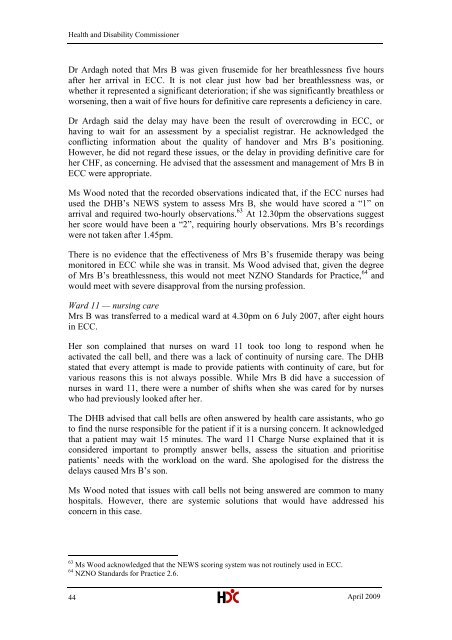North Shore Hospital report - New Zealand Doctor
North Shore Hospital report - New Zealand Doctor
North Shore Hospital report - New Zealand Doctor
You also want an ePaper? Increase the reach of your titles
YUMPU automatically turns print PDFs into web optimized ePapers that Google loves.
Health and Disability CommissionerDr Ardagh noted that Mrs B was given frusemide for her breathlessness five hoursafter her arrival in ECC. It is not clear just how bad her breathlessness was, orwhether it represented a significant deterioration; if she was significantly breathless orworsening, then a wait of five hours for definitive care represents a deficiency in care.Dr Ardagh said the delay may have been the result of overcrowding in ECC, orhaving to wait for an assessment by a specialist registrar. He acknowledged theconflicting information about the quality of handover and Mrs B‘s positioning.However, he did not regard these issues, or the delay in providing definitive care forher CHF, as concerning. He advised that the assessment and management of Mrs B inECC were appropriate.Ms Wood noted that the recorded observations indicated that, if the ECC nurses hadused the DHB‘s NEWS system to assess Mrs B, she would have scored a ―1‖ onarrival and required two-hourly observations. 63 At 12.30pm the observations suggesther score would have been a ―2‖, requiring hourly observations. Mrs B‘s recordingswere not taken after 1.45pm.There is no evidence that the effectiveness of Mrs B‘s frusemide therapy was beingmonitored in ECC while she was in transit. Ms Wood advised that, given the degreeof Mrs B‘s breathlessness, this would not meet NZNO Standards for Practice, 64 andwould meet with severe disapproval from the nursing profession.Ward 11 — nursing careMrs B was transferred to a medical ward at 4.30pm on 6 July 2007, after eight hoursin ECC.Her son complained that nurses on ward 11 took too long to respond when heactivated the call bell, and there was a lack of continuity of nursing care. The DHBstated that every attempt is made to provide patients with continuity of care, but forvarious reasons this is not always possible. While Mrs B did have a succession ofnurses in ward 11, there were a number of shifts when she was cared for by nurseswho had previously looked after her.The DHB advised that call bells are often answered by health care assistants, who goto find the nurse responsible for the patient if it is a nursing concern. It acknowledgedthat a patient may wait 15 minutes. The ward 11 Charge Nurse explained that it isconsidered important to promptly answer bells, assess the situation and prioritisepatients‘ needs with the workload on the ward. She apologised for the distress thedelays caused Mrs B‘s son.Ms Wood noted that issues with call bells not being answered are common to manyhospitals. However, there are systemic solutions that would have addressed hisconcern in this case.63 Ms Wood acknowledged that the NEWS scoring system was not routinely used in ECC.64 NZNO Standards for Practice 2.6.44April 2009
















